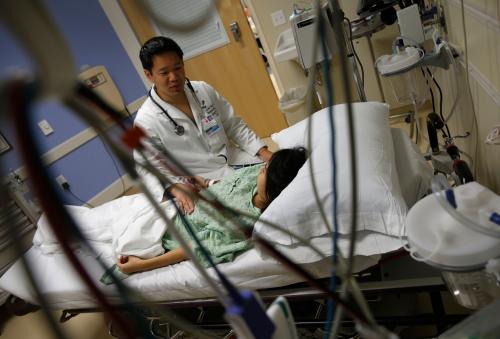The Centers for Medicare and Medicaid Services (CMS) recently launched a new initiative to curb the costs of health care services and empower patients to make more informed decisions about their medical care. The newly launched website, Procedure Price Lookup, increases the transparency of prices by allowing users to compare the total and out-of-pocket costs of certain medical procedures at hospital outpatient departments with those at ambulatory surgical centers. As CMS Administrator Seema Verma explains, “CMS and patients pay vastly different amounts for the same service, depending on the site of care.” Given the difference in payments, the new website will allow patients to choose between the two settings based on their respective costs.
While the new initiative is certainly a step forward, I believe its impact will be limited.
Patient costs versus Medicare costs
First, information about out-of-pocket costs may not be the most effective incentive for patients to choose treatments with smaller fees. Prior research shows that older and sicker patients are much less sensitive to the prices of health insurance premiums. We also know that while offering a price transparency tool may reduce the price paid for medical services, rarely anyone uses such tools, even among younger and healthier adults. It is very likely that the Medicare beneficiaries, who are older and sicker than the general population, are both less sensitive to out-of-pocket costs and much more reluctant to use the price transparency tool offered by Medicare.
This situation will be exacerbated because the differences of the out-of-pocket costs between the hospital outpatient department and ambulatory surgical centers are mostly minuscule. A quick analysis of the dollar amount of the difference between the out-of-pocket costs shows that close to 90 percent of medical procedures have less than $500 difference in out-of-pocket costs between the two settings. Although this may be a significant cost for many patients, compared to the total cost of the medical procedures, the out-of-pocket cost is negligible. Surprisingly, the out-of-pocket costs for patients for some of the most expensive medical procedures are significantly lower at hospital outpatient departments while the Medicare’s costs are significantly higher. This poorly designed payment structure incentivizes patients to choose a setting with lower out-of-pocket costs and higher Medicare costs.
Take the “insertion of retinal prosthesis” as an example. The procedure, also known as insertion of bionic eye or the retinal implant, is intended to provide electrical stimulation of the retina to induce visual perception in blind individuals. The out-of-pocket cost for patients is a whopping $23,500 if they choose to receive it in an ambulatory surgical center, compared to a capped $1,340 in a hospital outpatient department. This significant cost difference will convince most patients to receive the procedure at a hospital outpatient department. However, Medicare’s payment to the ambulatory surgical centers for this procedure is $27,000 less than to hospitals. In other words, by choosing a lower out-of-pocket cost option, patients will cost Medicare $27,000. There are 102 examples of such procedures in the Procedure Price Lookup dataset.
Second, Procedure Price Lookup only provides the cost information at a national average. This information is very limited and does not help patients make informed decisions at their local health care provider, especially given the fact that the costs of medical services vary widely between different locations. For example, the national average cost of a certain medical procedure may be higher for hospital outpatient departments than in ambulatory surgical units, but it is very likely that the cost is lower at hospitals in certain locations. In these situations, using the Procedure Price Lookup tool will inadvertently lead the patients to end up choosing the higher cost option.
Third, given the lack of sufficient information about the actual quality of medical services and the high level of uncertainty involved in medical decisionmaking, patients are likely to follow the recommendation of their physician. They may even use the cost of services as a proxy for quality and choose the ones that cost more, assuming that they may be receiving a higher quality service.
In summary, the service is very likely to have no effects at best, or even lead to a slight increase in the overall cost of medical services. To improve the potential impact of the tool, CMS may consider the following suggestions:
Provide location-specific price and quality information
Rather than merely providing patients with national averages of the costs of the services, CMS should provide the costs of medical procedures per each provider. This should accompany quality information such as readmission, complications, and death rates for each location. Like other services and products, a comparison of costs can be meaningful only if the quality information is also available. Patients should know if they are paying a premium for higher quality of services, or if they are just being charged extra while receiving a relatively similar service.
Encourage patients to use the Procedure Price Lookup website
As long as patients do not use this tool, its potential benefits will not be realized. CMS should increase the use of the website by informing patients about its existence and its benefits through various media campaigns on different outlets.
Aggregate hospital price lists data
Since January 1, 2019, hospitals are mandated to publicly post their price lists in a machine readable format on their websites. This has resulted in more confusion than clarity simply because the lists are still extremely complicated. Patients can hardly understand the jargon, and therefore cannot effectively use the price lists. Instead of posting the prices on their websites, hospitals should be required to report directly to CMS so that the agency can provide a comprehensive data feed through application programming interfaces (APIs) to the public. This will enable private businesses to create platforms that enable patients to easily compare the prices and choose between hospitals. The platform could be similar in form and functionality to already existing websites that allow customers to search and compare airline or hotel prices in one place.










Commentary
Procedure Price Lookup: A step toward transparency in the health care system
January 30, 2019